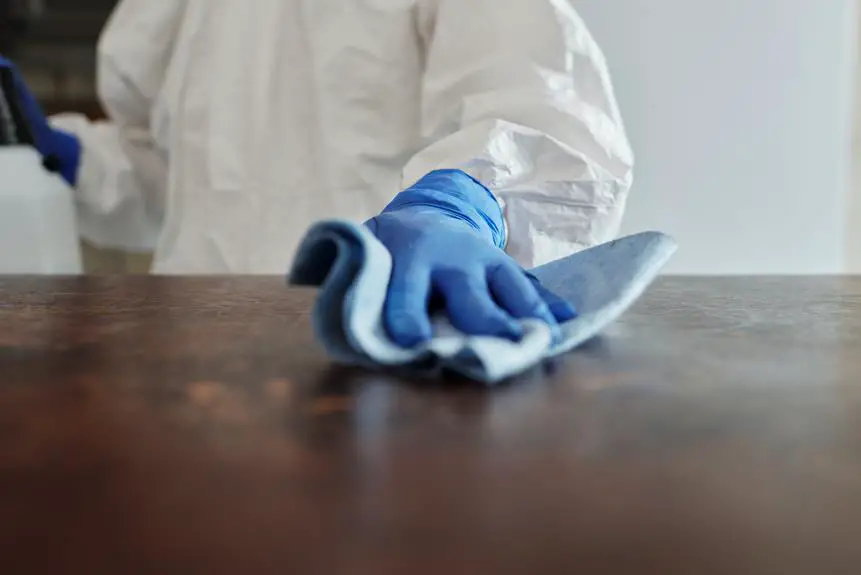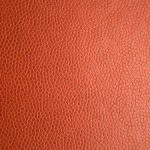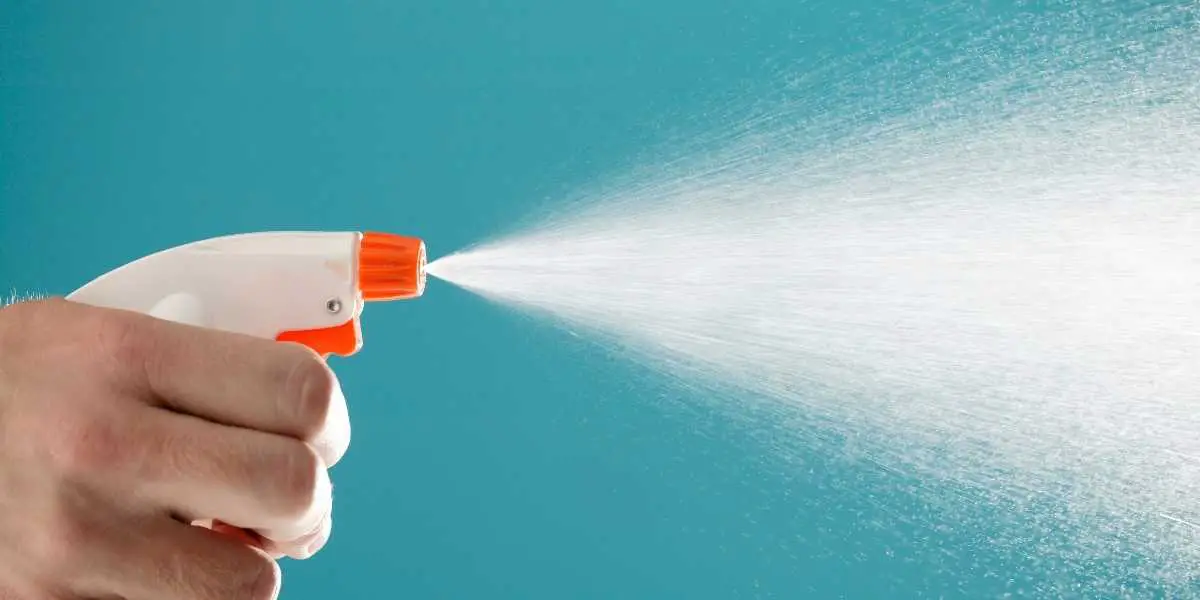Did you know that over 60% of people are unsure whether Lysol Disinfectant Spray can be safely used on fabrics? Understanding how to properly disinfect your fabrics is crucial for maintaining a clean and healthy home environment.
In this guide, you'll learn about the compatibility of Lysol Disinfectant Spray with various fabrics, as well as the proper application techniques to ensure effective disinfection. We'll also explore any potential risks to fabrics and provide alternatives for delicate materials.
By the end, you'll have the mastery to confidently use Lysol Disinfectant Spray on fabrics while safeguarding their integrity. Let's dive in and ensure your fabrics are not only clean but also disinfected.
Key Takeaways
- It is important to read the manufacturer's instructions and check for any warnings or precautions related to fabric use before using Lysol Disinfectant Spray on fabrics.
- Conduct a patch test on a small, inconspicuous area of the fabric to check for adverse reactions before applying Lysol Disinfectant Spray.
- Disinfectant sprays may contain chemicals that can cause discoloration, weakening of fibers, or overall deterioration of the fabric, so it is important to assess fabric compatibility before applying Lysol Disinfectant Spray.
- Proper drying time is essential for the disinfectant to effectively penetrate and eliminate germs and bacteria, so it is important to allow the fabric to air dry completely before using or handling.
Lysol Disinfectant Spray: Fabric Safety
Yes, you can use Lysol Disinfectant Spray on fabrics, but with caution and following specific guidelines for fabric safety. When it comes to fabric care, it's important to consider the disinfectant efficiency of Lysol and its impact on different types of fabrics.
Before using Lysol Disinfectant Spray on fabrics, it's crucial to read the manufacturer's instructions and check for any warnings or precautions related to fabric use. Some fabrics may be more sensitive to disinfectants and could be damaged if not used properly.
To ensure fabric safety, start by spot-testing the spray on a small, inconspicuous area of the fabric and check for any adverse reactions such as discoloration or damage. If the fabric shows no negative effects after testing, you can proceed to lightly mist the fabric with the disinfectant spray, making sure not to oversaturate it.
After applying the spray, allow the fabric to air dry completely before using or wearing it. Always follow the specific guidelines provided by the manufacturer for the best results and to prevent any potential damage to the fabric.
Taking these precautions will help you maintain fabric safety while utilizing the disinfectant efficiency of Lysol.
Understanding Fabric Compatibility
Assess fabric compatibility before applying Lysol Disinfectant Spray to ensure optimal results and prevent potential damage. Not all fabrics are created equal, and some may react poorly to disinfectant application. Always check the fabric care label for any specific instructions or warnings related to disinfectant use. Some fabrics may be sensitive to certain chemicals present in disinfectant sprays, which could lead to discoloration, weakening of fibers, or overall deterioration of the fabric. It's crucial to understand that while Lysol Disinfectant Spray is effective in killing germs, it may not be suitable for all fabric types.
Before proceeding with disinfectant application, it's advisable to conduct a patch test on a small, inconspicuous area of the fabric. This can help determine whether the fabric is compatible with the disinfectant spray. If there are no adverse effects after a reasonable amount of time, it's likely safe to proceed with disinfecting the entire fabric. Taking these precautions can help maintain the quality and longevity of your fabrics while ensuring effective disinfection.
Proper Application Techniques
When using Lysol Disinfectant Spray on fabrics, it's important to consider fabric compatibility, spray distance, and drying time.
To ensure effective disinfection, always check the fabric's compatibility with the spray and maintain the recommended spray distance for even coverage.
Additionally, allow the fabric to fully dry before using or wearing to maximize the disinfecting effects.
Fabric Compatibility Tips
You can safely use Lysol Disinfectant Spray on fabrics by following these fabric compatibility tips and proper application techniques.
- Check fabric label for cleaning instructions
- Test a small, inconspicuous area first
- Hold the spray nozzle at least 6 inches away from the fabric
When using Lysol Disinfectant Spray on fabrics, always check the fabric label for any specific cleaning instructions or warnings. Additionally, it's crucial to test a small, inconspicuous area of the fabric first to ensure compatibility and avoid any potential damage. When applying the spray, hold the nozzle at least 6 inches away from the fabric to achieve even coverage without causing any soaking.
Spray Distance Recommendations
To achieve even coverage without causing soaking, hold the spray nozzle at least 6 inches away from the fabric when using Lysol Disinfectant Spray on fabrics. Maintaining this distance ensures that the spray disperses evenly, covering the fabric without saturating it.
When applying the spray, use a sweeping motion to cover the entire fabric surface, moving the can from side to side. This technique helps prevent over-saturation in one area while ensuring that the entire fabric receives adequate coverage.
Drying Time Considerations
Once the fabric has been properly sprayed with Lysol Disinfectant Spray, allow it to air dry completely before using or handling. Proper drying time is essential for the disinfectant to effectively penetrate and eliminate germs and bacteria. When considering drying time for fabrics sprayed with Lysol Disinfectant Spray, it's important to keep in mind the fabric absorption rate and environmental factors that may affect drying, such as humidity and airflow.
Here are some key considerations for drying time:
- Ensure proper ventilation to expedite drying process.
- For thicker fabrics, consider allowing additional drying time to ensure thorough disinfection.
- Avoid using or handling the fabric until it's completely dry to maximize the effectiveness of the disinfectant.
Potential Risks to Fabrics
Spraying Lysol Disinfectant on fabrics can potentially cause discoloration, fading, or damage to the material. It's crucial to consider fabric compatibility before applying Lysol Disinfectant Spray. Some fabrics may be more sensitive to the chemicals in the spray, leading to adverse effects. When using the disinfectant, it's important to test it on a small, inconspicuous area of the fabric first to ensure that it doesn't cause any discoloration or damage.
The application of Lysol Disinfectant Spray should be done cautiously, taking care to avoid oversaturation. Overly saturating the fabric with the spray can increase the risk of discoloration or damage. Additionally, it's essential to follow the instructions on the product label, as misuse can lead to adverse effects on the fabric.
It's important to note that prolonged or repeated use of Lysol Disinfectant Spray on fabrics may increase the likelihood of negative effects. Therefore, it's advisable to use the spray sparingly and consider alternative disinfecting methods for fabrics, especially for delicate or sensitive materials.
Being mindful of these potential risks and taking appropriate precautions can help preserve the quality and appearance of fabrics when using Lysol Disinfectant Spray.
Alternatives for Delicate Fabrics
If you have delicate fabrics, consider using alternative disinfecting methods to avoid potential damage from Lysol Disinfectant Spray. When dealing with sensitive materials, there are several alternative methods you can use to effectively disinfect without risking harm to your fabrics:
- Steam Cleaning: Steam can effectively kill germs and bacteria on delicate fabrics without causing damage. Using a handheld steamer or a garment steamer can be a gentle alternative to chemical disinfectants.
- White Vinegar: White vinegar is known for its disinfectant properties and can be used as a natural alternative to harsh chemical sprays. Mix equal parts of water and white vinegar in a spray bottle and lightly mist the fabric, then allow it to air dry.
- Baking Soda: Baking soda is another natural disinfectant that can be used to freshen and disinfect delicate fabrics. Simply sprinkle a small amount of baking soda on the fabric, let it sit for a few hours, and then gently vacuum it off.
These alternative methods provide effective ways to disinfect delicate fabrics without causing damage, allowing you to maintain the integrity of your sensitive materials.
Tips for Removing Odors From Fabrics
You can easily remove odors from fabrics by using a mixture of white vinegar and water in a spray bottle. Mix equal parts of white vinegar and water and spray the solution onto the fabric. Let it air dry, and the vinegar smell will dissipate, taking the unwanted odors with it.
Another effective method is to sprinkle baking soda on the fabric, let it sit for a few hours, and then vacuum it off. Baking soda is known for its odor-absorbing properties.
For removing stubborn odors, consider using an enzymatic cleaner designed specifically for fabrics. These cleaners contain enzymes that break down organic material causing the odor.
Additionally, steam cleaning is a great way to freshen upholstery and remove odors. The high temperature of the steam helps to kill odor-causing bacteria and freshen the fabric.
When dealing with tougher odors, it's important to address the source of the problem. Identify and remove any stains or spills that may be contributing to the odor.
Regular maintenance and cleaning can help prevent odors from becoming deeply embedded in fabrics.
Ensuring Effective Disinfection
You want to ensure that your fabric disinfection is effective. Using fabric-safe disinfectant options is crucial to maintaining the integrity of your fabrics while effectively sanitizing them.
Lysol can be used on soft surfaces, but it's important to follow the instructions for proper application to achieve effective fabric sanitation.
Fabric-Safe Disinfectant Options
When disinfecting fabrics, it's important to consider fabric-safe disinfectant options to ensure effective disinfection. Here are some fabric-safe disinfectant options to consider:
- Hydrogen peroxide: An effective and gentle disinfectant suitable for most fabrics.
- White vinegar: Acts as a natural disinfectant and deodorizer, safe for most fabrics.
- Alcohol-based sprays: Look for sprays with at least 70% alcohol for effective disinfection of fabrics.
These fabric-safe disinfectant options provide a balance between effectively eliminating germs and ensuring the safety of your fabrics. Always spot test a small, inconspicuous area of the fabric before full application to ensure compatibility and avoid any potential damage.
Lysol on Soft Surfaces
To ensure effective disinfection, always apply a small amount of Lysol Disinfectant Spray on a hidden area of the fabric before proceeding with full application. This precaution helps to ensure that the fabric is compatible with the spray and won't be damaged by it. When applying Lysol spray to soft surfaces, it's essential to follow proper fabric care and disinfectant application guidelines to achieve effective soft surface sanitation. Here's a quick reference guide for using Lysol Disinfectant Spray on soft surfaces:
| Soft Surface | Application Process | Notes |
|---|---|---|
| Upholstery | Test on hidden area first | Do not oversaturate the fabric |
| Curtains | Light misting from a distance | Allow to air dry completely |
| Bedding | Light spray evenly over surface | Wash bedding regularly as well |
Effective Fabric Sanitation
For effective fabric sanitation and ensuring thorough disinfection, it's important to follow specific application guidelines. When it comes to fabric disinfection and care, here are some key points to consider:
- Read the label: Always check the manufacturer's instructions on the disinfectant product to ensure it's safe for use on fabrics.
- Spot test: Before applying any disinfectant spray or solution to a large area of fabric, it's crucial to conduct a spot test on a small, inconspicuous area to check for any adverse reactions.
- Proper ventilation: When using disinfectant sprays on fabrics, ensure the area is well-ventilated to prevent the inhalation of potentially harmful fumes.
Following these guidelines will help you effectively sanitize and disinfect your fabrics while ensuring their longevity and care.
Conclusion and Final Recommendations
You should always adhere to the manufacturer's guidelines when using Lysol Disinfectant Spray on fabrics.
While the spray can effectively disinfect fabrics, it's crucial to ensure that it won't cause damage or discoloration.
If you're looking to sanitize fabrics, Lysol Disinfectant Spray can be a valuable tool, but for certain delicate fabrics or items with specific care instructions, it's best to consult the manufacturer or a professional cleaner.
Additionally, for fabric odor removal, there are alternatives to using Lysol Disinfectant Spray. Consider using baking soda, white vinegar, or specialized fabric sprays to effectively eliminate odors without the potential risks associated with using disinfectant sprays.
Always test any new cleaning or disinfecting product on a small, inconspicuous area of the fabric before widespread use to ensure that it won't cause any adverse effects.
Ultimately, while Lysol Disinfectant Spray can be effective for fabric disinfection, it's important to be mindful of the fabric type and any specific care instructions to maintain the fabric's quality and appearance.
Frequently Asked Questions
Can Lysol Disinfectant Spray Be Used on Dry Clean Only Fabrics?
Yes, Lysol Disinfectant Spray is effective on fabrics, but it's important to check the fabric compatibility and avoid using it on dry clean only fabrics. Always spot test in an inconspicuous area first.
Will Lysol Disinfectant Spray Cause Discoloration or Fading on Colored Fabrics?
You should test the colorfastness of your fabric before using Lysol Disinfectant Spray. Check fabric compatibility and apply the spray using a gentle method. Also, consider the fabric's stain resistance to avoid discoloration or fading.
Is It Safe to Use Lysol Disinfectant Spray on Delicate or Sensitive Fabrics Such as Silk or Lace?
Yes, it's safe to use Lysol Disinfectant Spray on delicate fabrics like silk, but always test a small, hidden area first. For lace, take precautions by spraying lightly and avoiding soaking. Follow the fabric care instructions for best results.
Can Lysol Disinfectant Spray Effectively Remove Pet Odors From Fabrics?
To effectively remove tough pet odors from fabrics, Lysol Disinfectant Spray can be used. Its powerful disinfecting properties aid in odor elimination, leaving fabrics smelling fresh. Ensure proper ventilation and spot test on a hidden area first.
Are There Any Specific Precautions to Take When Using Lysol Disinfectant Spray on Children's Clothing or Baby Blankets?
When using Lysol Disinfectant Spray on children's clothing or baby blankets, take precautions to ensure proper ventilation and avoid direct contact with skin. Follow recommended application methods for safe and effective disinfection.
- Does Chiffon Fabric Stink - July 15, 2025
- Does Chiffon Fabric Affect the Economy - July 15, 2025
- Does Cotton Fabric Have a Nap - July 15, 2025







